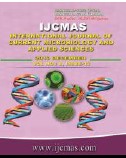


 National Academy of Agricultural Sciences (NAAS)
National Academy of Agricultural Sciences (NAAS)

|
PRINT ISSN : 2319-7692
Online ISSN : 2319-7706 Issues : 12 per year Publisher : Excellent Publishers Email : editorijcmas@gmail.com / submit@ijcmas.com Editor-in-chief: Dr.M.Prakash Index Copernicus ICV 2018: 95.39 NAAS RATING 2020: 5.38 |
A field experiment was conducted under All India Coordinated Research Project on Cashew, Zonal Research Station, Darisai, Birsa Agricultural University, Ranchi, Jharkhand India during the year 2017-2018 to study the interaction effect of planting density and nutrient management on growth and yield of cashew variety BPP 8.The experiment was laid out in a split plot design with three planting densities [S1 =10m x 5m (200 plants/ ha); S2 =6m x 4m (400 plants/ ha) and S3 =5 m x 4 m (500 plants/ha)] along with three levels of fertilizer (M1 =75-25-25, M2 =150-50-50 and M3 =225-75-75 kg NPK ha-1) and replicated three times. The overall results indicated significant influence of both planting density and nutrient management on growth and yield of cashew, however, non significant effect was observed in their interactions. Among the planting densities, adoption of planting densityS2=6mx4m (400 plants/ha) not only realized significantly better vegetative growth, i.e., mean tree height (4.47 m), mean stem girth (62.40 cm), mean canopy spread N-S (4.97 m), E-W (4.85 m) but also mean flowering lateral/m2 (20.4), nut yield attributing parameters such as mean nut weight (7.20 g), mean apple weight (51.53 g) and mean nut yield kg/tree (5.74 kg/tree) as well as cumulative nut yield for three harvests per plant basis (22.96 kg/plant). The result also revealed that interaction of 10m x 5m planting density and moderate level fertilizer (150-50-50 kg NPK ha-1) found highest vegetative growth; mean tree height (4.64 m), mean stem girth (65.40 cm), mean canopy spread N-S (6.61 m), E-W (6.96 m), mean nut weight (7.86 g), mean nut yield kg/tree (6.63 kg/tree) as well as cumulative nut yield for three harvests per plant basis (10.73 kg/plant).
 |
 |
 |
 |
 |